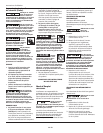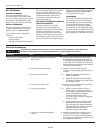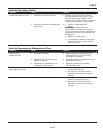
5
TL0517
www.chpower.com
Operating Instructions
(Continued)
RECOMMENDED HOOKUP
The illustration below shows the
recommended hookup for the tool.
1. The air compressor
must be able to
maintain a minimum
of 60 psi when the
tool is being used. An inadequate air
supply can cause a loss of power and
inconsistent driving.
2. An oiler can be
used to provide oil
circulation through
the tool. A filter can
be used to remove liquid and solid
impurities which can rust or “gum
up” internal parts of the tool.
3. Always use air supply hoses with
a minimum working pressure
rating equal to or greater than the
pressure from the power source if a
regulator fails, or 200 psi, whichever
is greater. Use 1/4 inch air hose for
runs up to 50 feet. Use 3/8 inch air
hoses for 50 foot run or longer.
4. Use a pressure regulator on the
compressor, with an operating
pressure of 0 psi - 125 psi. A pressure
regulator is required to control
the operating pressure of the tool
between 60 psi and 90 psi.
REGULATOR OPERATION
This impact wrench is equipped with
several power (speed) settings. Use the
switch on the rear of the tool to select
the proper setting before operating
tool. The tool has 3 forward settings
and 1 reverse setting. Do not change
settings while tool is running.
SPEED ADJUSTMENT
An impact wrench should never be used
to set torque. Use a torque wrench to
set the torque.
To remove lugs or bolts, set the
regulator to the maximum setting.
When installing, always use a torque
wrench to attain the proper torque of
the lugs or bolts.
When reassembling
be careful not to
overtighten. Bolts may fail or cause a
hazardous condition. Be sure to set the
regulator to the minimum setting then
use a torque wrench to set torque.
NOTE: It is not recommended to install
a quick coupler between the tool and
the whip hose.
Using fittings or air hoses which are
too small can create a pressure drop
and reduce the power of the tool. For
3/8, 1/2 and 3/4 inch impact wrenches
use 3/8 inch (I.D.) fittings with 1/4 inch
NPT threads. Most compressors are
shipped with a short, 1/4 inch I.D. hose.
For proper performance and more
convenience, use a 3/8 inch I.D. hose.
Hoses longer than 50 feet should have a
1/2 inch I.D.
Never carry a tool
by the hose or
pull the hose to move the tool or a
compressor. Keep hoses away from
heat, oil and sharp edges. Replace any
hose that is damaged, weak or worn.
User-Maintenance
Instructions
TECHNICAL SERVICE
Please call our Tool Hotline at 1-800-
543-6400 with any questions regarding
the operation or repair of this tool or
for additional copies of this manual.
REPLACEMENT PARTS INFORMATION
For information regarding where to
order replacement parts, call toll free
1-800-543-8622. Please provide the
following information:
•Modelnumber
•Stamped-incode
•Partnumberanddescription
TOOL REPAIR
Only qualified personnel should repair
the tool and they should use genuine
Campbell Hausfeld replacement parts
and accessories, or parts and accessories
which perform equivalently.
ASSEMBLY PROCEDURE FOR SEALS
When repairing a tool, the internal
parts must be cleaned and lubricated.
Parker O-lube or equivalent must be
used on all o-rings. Each o-ring must be
coated with O-lube before assembling.
A small amount of oil must be used on
all moving surfaces and pivots. After
reassembling, a few drops of 30W
non-detergent oil or equivalent, must
be added through the air line before
testing.
200 psi or greater
3/8 inch I.D.
Recommended Hookup
Quick Plug
Quick
Coupler
Air Hose
Quick Plug
(Optional)
Quick
Coupler
(Optional)
Regulator
Lubricator Filter
60 psi
Min.
90 psi
Max.


















